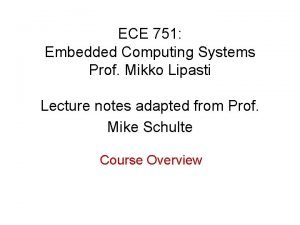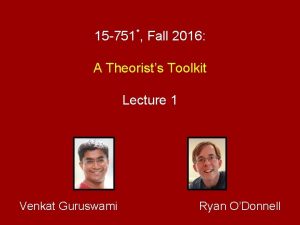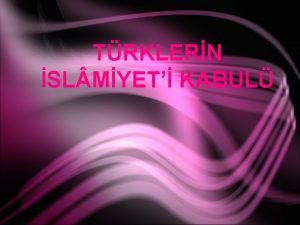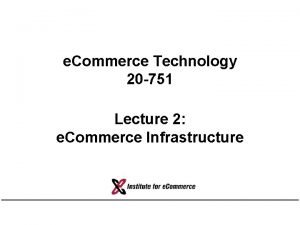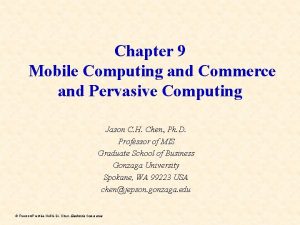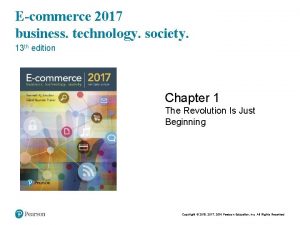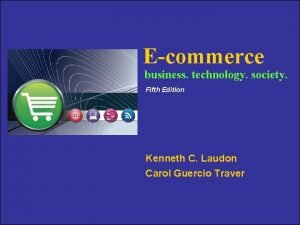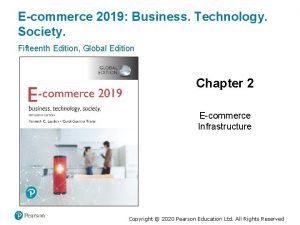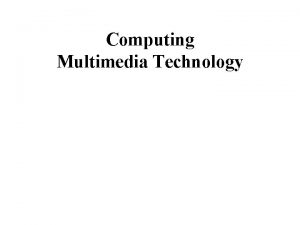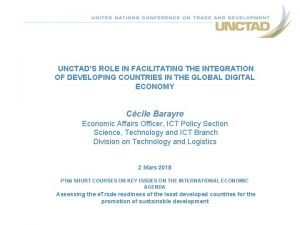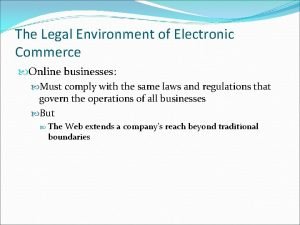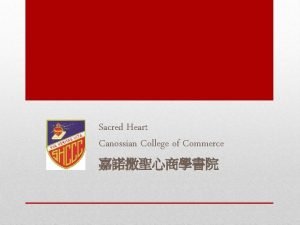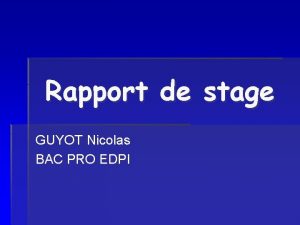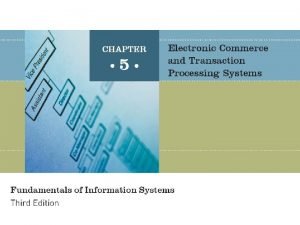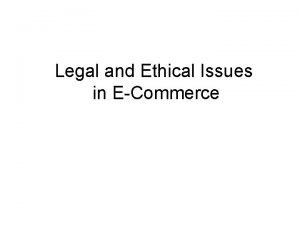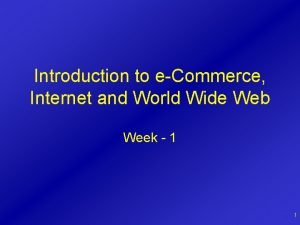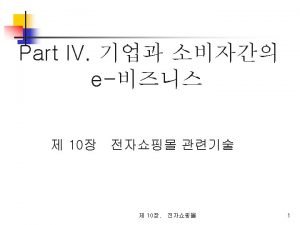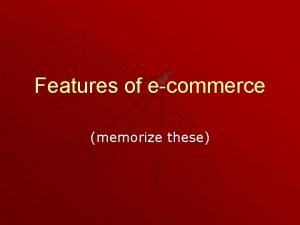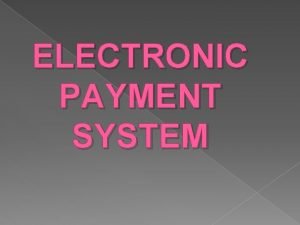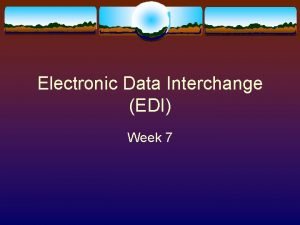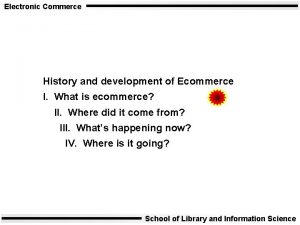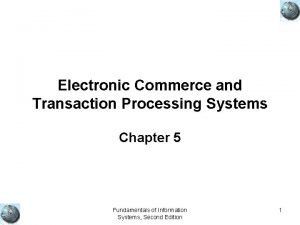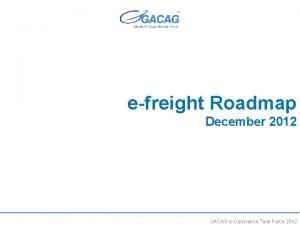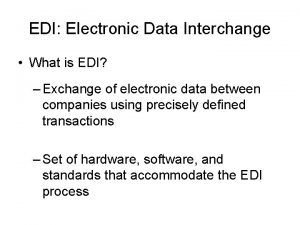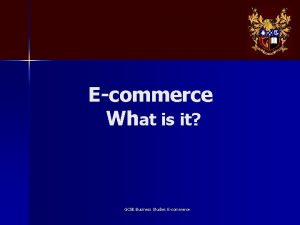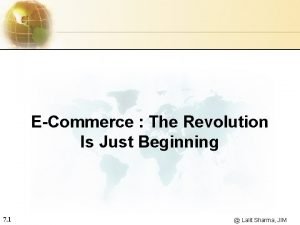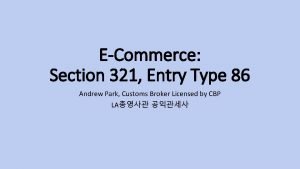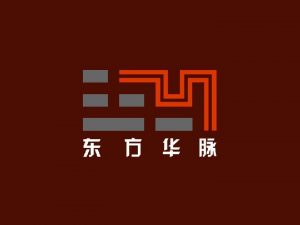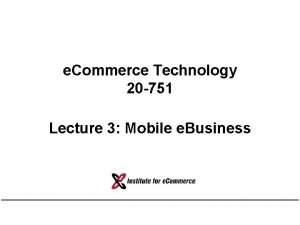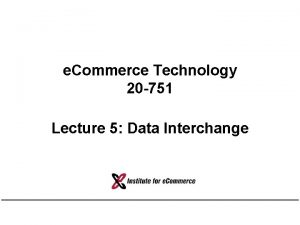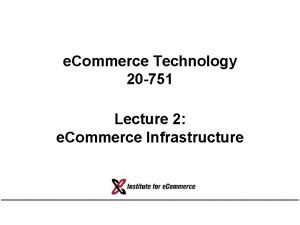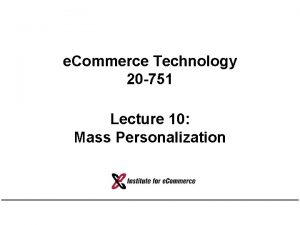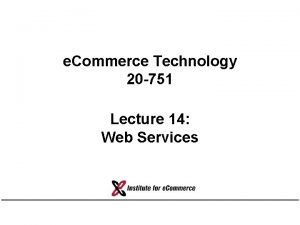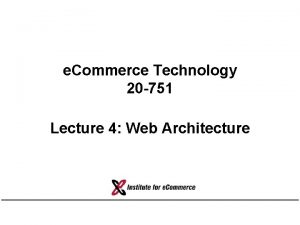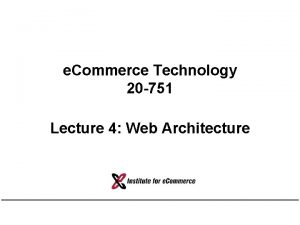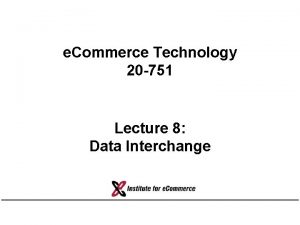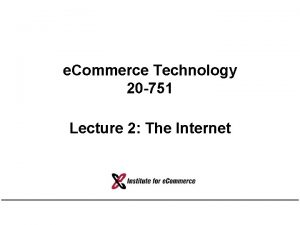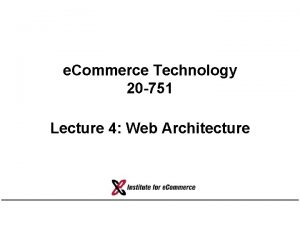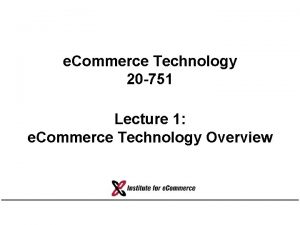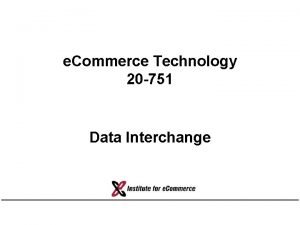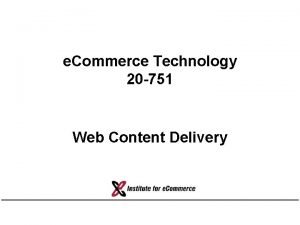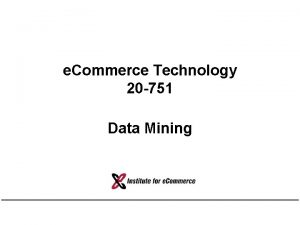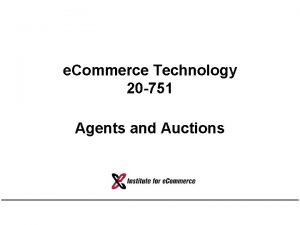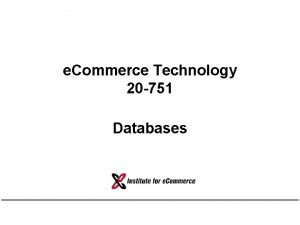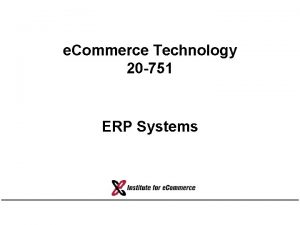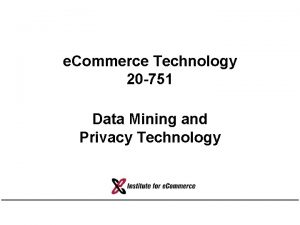e Commerce Technology 20 751 Lecture 6 Multimedia












































- Slides: 44

e. Commerce Technology 20 -751 Lecture 6: Multimedia

MULTIMEDIA • Which media can be delivered remotely? – Text, graphics, audio, video, motion picture, virtual reality • What are the limitations? – Speed, resolution, fidelity, color • How are they created? • How are they stored? – File formats: GIF, TIFF, JPEG, MPEG, . . . • How are they displayed (put in web pages)?

Pixels (Picture Cells) Discrete array of cells holding gray-scale data 1 -bit (black or white) 8 -bit (0 - 255) To represent color, use multiple pixel arrays (usually 3)

RGB (Additive) Color Space CREATING COLORS BY ADDING RED, GREEN + BLUE • • RGB SCREEN PHOSOPHORS R, G, B each indicated by intensity 0 -255 (24 bits) Additive color applet Visibone color selector RGB, RBW, HSV, RGYB, HLS, YIQ converter

Gamut (full range of colors) Gray = human visible range 1. WIDE-GAMUT RGB 2. HDTV (SM PTE 240 -M) 3. Custom RGB 4. Color. Match RGB 5. s. RGB (average monitor) CYM = cyan, magenta, yellow (subtractive)

YUV Color Space • Y = luminance (brightness, intensity of yellow) • U, V = chrominance (difference between a color and yellow) U = B - Y, V = R - Y • YUV is used in TV SOURCE: N. BARNETT, VA. TECH.

YUV Color Space Y = 0. 299 R + 0. 587 G + 0. 114 B U = 0. 492 (B - Y) V = 0. 877 (R - Y)

Bit Depth 16, 777, 216 COLORS 256 COLORS 16 COLORS 2 COLORS: B, W

Dithering • • File contains color information system can’t display Dithering is approximating a non-displayable color Image dithering: replace with 2 or more colors Screen dithering (substitution): replace with 1 color IMAGE-DITHERED VERSION OF MARKED DETAIL AREA SOURCE: R. LINEBACK

Palettes • The palette is the range of colors available for display • A palette is browser-safe if it can be displayed on all popular browsers • A browser-safe palette • Netscape color palette map

Netscape (Non-Dithering) Palette RGB (0%, 20%, 40%, 60%, 80%, 100%) 0% 20% 40% 60% 80% 100% = = = 0 51 102 153 204 255 = = = Hex Hex Hex 00 33 66 99 CC FF 6 choices for each of R, G, B = 216 colors SOURCE: WEBREFERENCE. COM

Palette of Indexed Colors • Color values indicate one of a set of an arbitrary set of colors, not RBG mixture. (LUT = look-up table) SOURCE: HANDBOOK OF GRAPHIC FILE FORMATS

Compression • • • There’s never enough space File (string) is a representation of information A representation (encoding) has a size Compression means reducing encoding size When can a string be compressed? – 00001000010000100001 – (00001)1000 means “ 00001” repeated 8 times – But some 40 -bit strings will get longer this way

Compression • An encoding is a “program” for generating the string • Strings having short programs can be compressed • Strings without short programs (Chaitin-Kolmogorov “random” strings) can’t be compressed • Compression limit: – n bits can only encode 2 n different strings • Dirichlet pigeonhole principle – If p+1 pigeons fly into p holes, some hole has more than one pigeon • Try to encode > 2 n strings in n bits loses information

Run-Length Encoding (RLE) • A run is a repeated character • Represent a run by two bytes: RUN-LENGTH CHARACTER • String “AAAAAAbbb. XXXXXt” (15 characters) become “ 6 A 3 b 5 X 1 t” (8 characters) • Advantages of RLE: fast, easy to code • What happens in RLE if no character is repeated?

3 -Byte Run-Length Encoding For repeated characters, use 3 bytes: “flag” + 2 - byte RLE. For solo characters, use 1 byte. SOURCE: HANDBOOK OF GRAPHIC FILE FORMATS

Bitmap (BMP) Format • Header • Bitmap data (indexed color or RGB) – 1, 4, 8, 16, 24, 32 - bit color • Palette • RLE, otherwise uncompressed • Generally very large

Dictionary Compression • Idea: choose a dictionary with < 65, 535 words • Number the words: – administration (3773), administrations (3774), fascinating (11012), xylophone (43722) • Every word can be represented by 2 bytes. (2 bytes = 16 bits = 0. . 65535) • Works for text • Doesn’t work for graphics

LZW (Lempel-Ziv-Welch) Compression • • • Start dictionary with all 1 -character strings C is next input character, P is empty Is P | C in the dictionary? If so, let P = P | C If not, – Output the code for P – Add P | C to the dictionary (and give it a code) – Set P = C • Repeat from “Is” until last character is seen, then output the code for P LZW Explanation Page (Mc. Gill)

LZW (Lempel-Ziv-Welch) Compression A B 1 2 B 3 A 4 B 5 A B 6 7 A C & 8 9 Dictionary = (1) A (2) B (3) C Step Pos 1 1 1 2 2 3 3 4 4 5 6 6 7 7 8 8 9 6 10 P A B B A AB ABA C C A B B A B A C Dict. Output (4) A B (5) B B (6) B A 1 2 2 (7) A B A 4 (8) A B A C 7 3 ALGORITHM: Is P | C in the dictionary? If so, let P = P | C If not, Output the code for P P | C dict (new code) Set P = C 1 2 2 4 7 3 = A B B A B A C! Dictionary not stored!

Graphic Image File (GIF) Format GIF identifier Screen dimensions Indexed color palette Position and size of image Indexed color palette LZW compressed data

GIF Compression • Since LZW is used, compression depends on randomness of image 941 BYTES 1004 BYTES 1452 BYTES 1803 BYTES 1239 BYTES 6685 BYTES SOURCE: KILLERSITES. COM

Compression Tradeoffs • Size v. Quality. bmp. gif. jpg 1000 KB, 172 KB, 47 KB, 13 KB, compression factor = 1 compression = 5. 8 high quality, compression = 21 low quality, compression = 75 • Size v. processing time – time to compress – time to decompress – not necessarily equal

Lossless v. Lossy Compression • A method of compression is “lossless” if no two strings become identical when compressed – RLE and LZW are lossless • Lossy compression: at least two strings compress to the same result – Example: Compress a 32 -bit string by taking just the first (leftmost) 16 bits (truncation) – If both A and B yield the compressed string C, we have “lost” the ability to recover the original • Lossy compression is OK for images if all possible decodings of C “look” almost the same

JPEG Format • JPEG = Joint Photographic Experts Group • Lossy compression • Discards visual info not seen by human eye (perceptual encoding) – slight changes in color not visible – slight changes in intensity easily visible – So, sacrifice color info in favor of intensity • Typical compression of 25: 1 without degradation • User can control quality

COMPRESSION RATIO 13. 5 SOURCE: NCSU

COMPRESSION RATIO 32. 4 SOURCE: NCSU

JPEG Compression CHANGE COLOR SPACE REDUCE COLOR INFO DISCRETE COSINE TRANSFORM DISCARD HIGH FREQUENCIES COMPRESS RESULT

JPEG Format • Operates on blocks of 8 x 8 pixels in the R, G and B planes • Must transform RGB into a color space that separates color from brightness:

Color Conversion and Downsampling • Must convert from RGB into a color space that separates color from brightness • Use YUV (human eye most sensitive to yellow) • Keep the Y (yellow luminance) data • Clip (shorten) the U, V data (U, V represent color differences so they are not very important)

Discrete Cosine Transform SOURCE: LULEÅ UNIV.

Discrete Cosine Transform

JPEQ Quantization (Truncation) • Idea: Threshold the values so that low ones (most of them) become zero:

Zig-Zag Run-Length Encoding • Zig-zag through the matrix so the tail of the sequence is all zeroes: 168, 45, 67, 12, 20, 7, 3, 3, 5, 2, 0, 0, 5, 3, 2, 0, 2, 2, 0, 0, . . . 64 numbers reduced to 18, a factor of ~ 4

JPEG Quality v. Compression One image is uncompressed (313 KB). One image is compressed by a factor of 13. 6 (23 KB). Which is which? SOURCE: E. DELP, PURDUE

JPEG Quality v. Compression NW: Quality = 75, Compression = 13. 6 NE: Q = 20, C = 37 SW: Q= 5, C = 78 SE: Q = 3, C= 96

JPEG Compression Example • Street scene from Simon Fraser University • Interactive JPEG example (Simon Fraser)

Sequential JPEG Image appears from top down:

Progressive JPEG Image “comes in” to focus:

Motion • Capture viewer – Requires concentration – Utilizes natural animal attention to movement • Involvement • Realism – Real-world object move • Convey message • Direct viewer’s attention

Delivering Video • Uncompressed video – 640 x 480 resolution – 24 -bit color = 7. 37 megabits/frame – 30 frames per second = 210 megabits/sec. – 1920 x 1080 = 1. 5 Gbps • Compressed video – MPEG-2. Broadcast quality. 15 Mbps – AVI, Quick. Time. 500 Kbps – Real. Networks. Designed for network speeds. 20 -200 Kbps. (At 20 Kbps, compression factor is greater than 10, 000. )

Streaming • Begin delivering content without full download – Lower latency – Low client storage requirement – Can start streaming at any point (not necessarily beginning – Live streaming possible (real-time compression) • Disadvantages – Lower quality, also affected by network connection – More time needed to compress – Need special server

1. True Streaming USER REQUESTS STREAMING MEDIA 2. 4. BROWSER REQUESTS pnm METAFILE BROWSER with video plug-in pnm METAFILE 5. CLIENT SIDE SERVER SIDE 3. SERVER UPLOADS METAFILE pnm METAFILE REALPLAYER PLUG-IN REQUESTS STREAM 6. WEB SERVER BROWSER INVOKES PLUG-IN REALSERVER UPLOADS STREAM REALSERVER STREAM

Q&A 20 -751 ECOMMERCE TECHNOLOGY SUMMER 2000 COPYRIGHT © 2000 MICHAEL I. SHAMOS
 Ece 751
Ece 751 Cs theory toolkit
Cs theory toolkit Violet miyets
Violet miyets تراکتور 751
تراکتور 751 Location-based commerce (l-commerce)
Location-based commerce (l-commerce) 01:640:244 lecture notes - lecture 15: plat, idah, farad
01:640:244 lecture notes - lecture 15: plat, idah, farad Multimedia becomes interactive multimedia when
Multimedia becomes interactive multimedia when Non multimedia system
Non multimedia system Multimedia becomes interactive multimedia when
Multimedia becomes interactive multimedia when Esa multimedia.esa.int./multimedia/virtual-tour-iss
Esa multimedia.esa.int./multimedia/virtual-tour-iss E commerce 2017 business technology society
E commerce 2017 business technology society E commerce business technology society
E commerce business technology society E commerce architecture and technologies in web technology
E commerce architecture and technologies in web technology E-commerce 2019: business, technology and society
E-commerce 2019: business, technology and society Define multimedia technology
Define multimedia technology Three pillars of e commerce
Three pillars of e commerce Intrastate vs interstate
Intrastate vs interstate Thessaloniki chamber of commerce and industry
Thessaloniki chamber of commerce and industry The legal environment of electronic commerce
The legal environment of electronic commerce Social commerce zone
Social commerce zone 嘉諾撒聖心商學書院
嘉諾撒聖心商學書院 Rapport de stage seconde pro
Rapport de stage seconde pro Objectives of e commerce
Objectives of e commerce Infrastructure of m commerce
Infrastructure of m commerce Drivers of m-commerce
Drivers of m-commerce Cisco commerce workspace
Cisco commerce workspace Difference between ethics and legality
Difference between ethics and legality Introduction to ecommerce
Introduction to ecommerce Social commerce esempi
Social commerce esempi Generic framework of e commerce
Generic framework of e commerce Example of universal standards in e-commerce
Example of universal standards in e-commerce Electronic payment definition
Electronic payment definition What is edi
What is edi History of ecommerce
History of ecommerce Tps it online commerce
Tps it online commerce Three pillars of e commerce
Three pillars of e commerce What is edi in e commerce
What is edi in e commerce E commerce gcse business
E commerce gcse business The revolution is just beginning
The revolution is just beginning Ecommerce website in sri lanka
Ecommerce website in sri lanka Cbp entry type 86
Cbp entry type 86 Mechanism of e commerce
Mechanism of e commerce E-commerce in your inbox: product recommendations at scale
E-commerce in your inbox: product recommendations at scale Ecommerce fundamentals
Ecommerce fundamentals E commerce
E commerce
